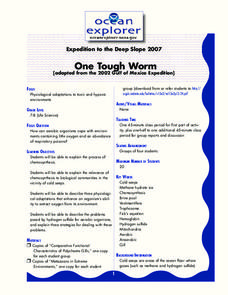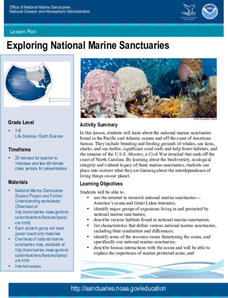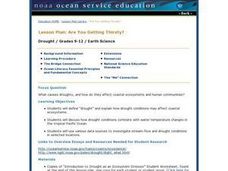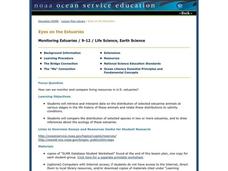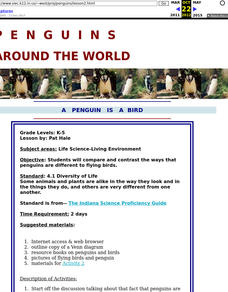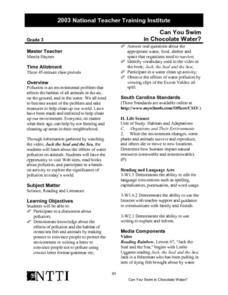Curated OER
Fish Fashion 101
Learners explore fish anatomy. In this fish anatomy and adaptation lesson, students define and identify the location of fish body parts. Learners add these parts of a fish's anatomy to a life-sized fish costume worn by a student. ...
Curated OER
No Place Like Home?
Students investigate the impact of the physical environment on an endangered species. They create a plan for the ideal care of the species and develop an advertisement to promote awareness about the need for its protection.
Curated OER
Corals & Coral Reefs
Students describe a coral reef, how it is formed and its inhabitants. They explain the ecological and economic importance of coral reefs and discuss its present-day threats. Lesson contains adaptations for all levels.
Curated OER
Monsters of the Deep
Students describe major features of cold seep communities and list the organisms that are typical in these communities. For this deep sea environment lesson students work in groups and research their given cold seep group.
Curated OER
One Tough Worm
Learners explain the process of chemosynthesis and its relevance to biological communities. In this investigative lesson plan students discuss chemosynthetic communities, then in groups they are assigned a species and are to calculate...
Curated OER
From the Gulf of Mexico to the Moons of Jupiter
High schoolers compare deep ocean conditions to those found on the moons of Jupiter. In this Earth science instructional activity, students consider the possibilities and conditions needed to support simple life. High schoolers examine...
Curated OER
Exploring Marine Ecosystems in the Caribbean and Maine
Students compare the marine habitats of Maine and the Caribbean using temperature, tides, ocean currents, latitude and longitude. In this marine ecosystems lesson, students analyze maps to complete graphic organizers that evaluate the...
Curated OER
Exploring National Marine Sanctuaries
Students conduct Internet research of the living organisms in national marine sanctuaries, and the resources protected in the sanctuaries. Students gather information about each of the sanctuaries and make an oral presentation and poster...
Curated OER
Are You Getting Thirsty?
Students study droughts and how they affect communities and coastal ecosystems. In this ecosystems lesson plan students use data to examine drought conditions in certain areas.
Curated OER
Sea Turtle Savvy
Students explore sea turtles. They create paper plate sea turtles and brainstorm other organisms that live in the sea turtle's habitat. They role-play scenes from a nonfiction book, A Baby Sea Turtle's Journey. They play a game...
Curated OER
The Environments of Big Sur -- Which Do We Protect?
Students investigate the geological, climatic, and biological features of Big Sur. They watch a video, conduct Internet research, and create a script and images in the form of an outline in a simulation of an environmental group.
Curated OER
What Do You Know About Horseshoe Crabs?
High schoolers create a learning tool based on information given on the assigned website. In this ocean life lesson, students read about the horseshoe crab and develop a worksheet, scavenger hunt, board game or any tool to aid learning....
Curated OER
Salt Marsh Plants and Animals
In this salt march plant and animals worksheet, students read descriptions of animals, then match each to its picture. Students then read about tidal animals and choose which animals in picture are most likely to be in a salt march at...
Curated OER
The Environments of Big Sur:Which Do We Protect?
Students examine the California environments. In this environmental lesson, students examine the various ecosystems of California, creating a presentation on how these environments impact Big Sur. They write a paper defending their point...
Curated OER
Save A Reef!
Students identify the major threats to coral reefs and the ways that they benefit from humans. In this coral reef conservation lesson students create a public education program on coral reefs.
Curated OER
It's not just pretty - it's a survival method!
First graders write explanations for why certain animals can only live in certain environments. In this animal survival lesson plan, 1st graders take pictures of animals and place them into the right environment after a instructional...
Curated OER
Is It Getting Hot In Here?
Students describe several factors and ways climate change could effect communities. In this climate change lesson students research climate change and complete a worksheet.
Curated OER
Prince William's Oily Mess: A Tale of Recovery
In this environment worksheet, students explore the effects of the Exxon Valdez oil spill. Students read and study text and photographs about the 1989 spill. Students answer 6 essay questions.
Curated OER
All Hands on Deck: A Harbor Education Program
Pupils build a model of an estuary. In this wetland instructional activity, students build a model estuary with a paint tray and modeling clay. They use the model to illustrate the impact of non-point pollution on the watershed.
Curated OER
Eyes on the Estuaries
Students study estuaries and compare several ones in the U.S. In this estuary lesson students interpret data and compare the distribution of different species.
Curated OER
Oil Slick Emergency
Pupils examine how to recover and remove oil from an oil spill. In this oil spill clean-up lesson students use role play and act like a committee to determine how to clean up an oil spill.
Curated OER
Breaking Away (Or Not...)
Students compare and contrast common reproductive strategies used by benthic invertebrates. They describe the most common reproductive strategies among benthic invertebrates on a seamount, and explain why these strategi
Curated OER
A Penguin is a Bird
Students compare and contrast the ways that penguins are different to flying birds.
Curated OER
Can You Swim in Chocolate Water?
Third graders discss water pollution and its affects on animals. They watch a demonstration using a plastic fish in a fish bowl in which various types of water pollution are illustrated.






